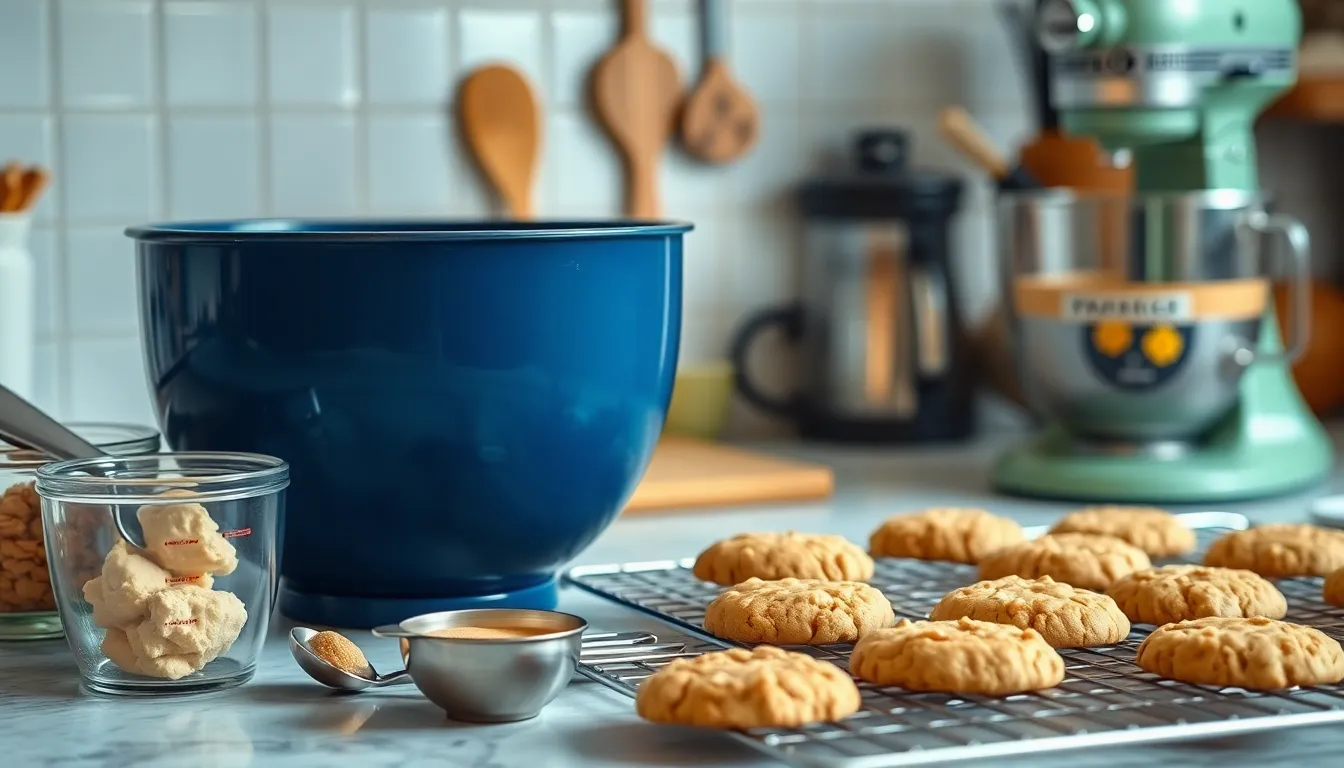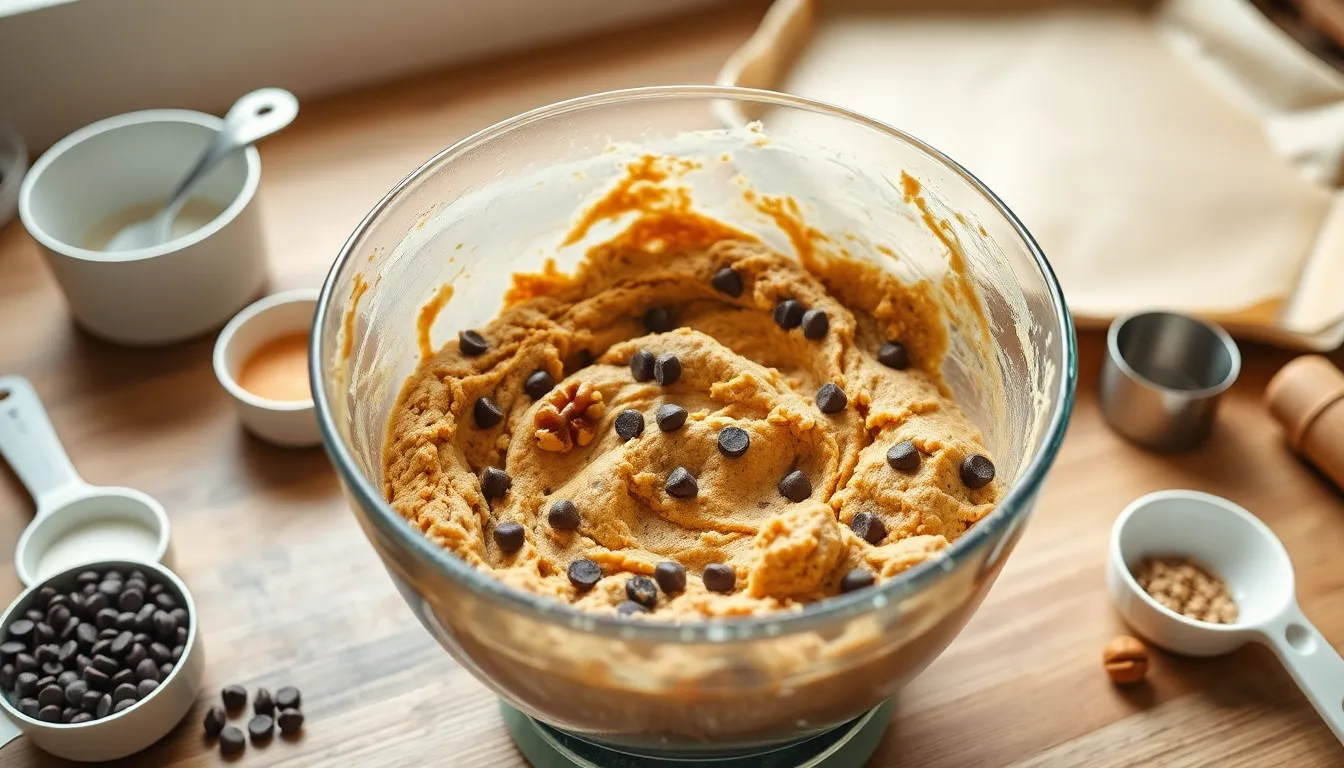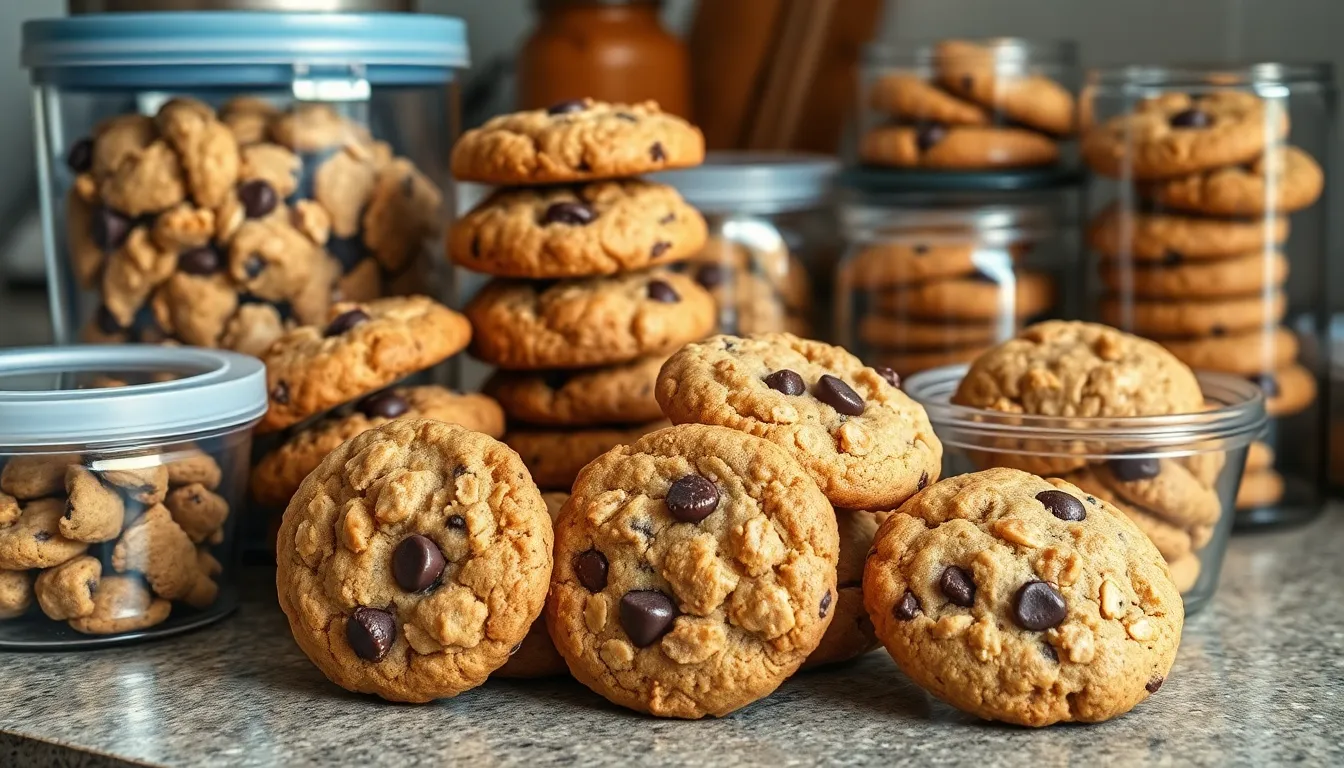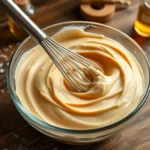We’ve discovered the secret to creating the most tender and flavorful cookies using oat flour – and trust us, once you try these, you’ll never go back to regular flour again. These oat flour cookies deliver a naturally sweet and nutty taste that’s both satisfying and wholesome.
What makes oat flour so special? It’s packed with fiber and protein while being naturally gluten-free, making these cookies perfect for anyone with dietary restrictions. The texture is incredibly soft and chewy, with a subtle oat flavor that pairs beautifully with chocolate chips, dried fruit, or nuts.
We love how simple these cookies are to make – you can even grind your own oat flour from rolled oats in just minutes. Whether you’re meal prepping healthy snacks or looking for a guilt-free dessert option, these oat flour cookies will become your new favorite treat that you’ll want to make again and again.
Ingredients
Our oat flour cookie recipe brings together simple pantry staples to create irresistibly soft and chewy treats. We’ve organized these ingredients into three categories to make preparation even easier.
Dry Ingredients
- 2 cups oat flour (or 2 cups old-fashioned rolled oats ground into flour)
- 1/2 teaspoon baking soda
- 1/2 teaspoon ground cinnamon
- 1/4 teaspoon salt
- 1/4 teaspoon ground nutmeg (optional)
Wet Ingredients
- 1/2 cup melted coconut oil or unsalted butter, cooled slightly
- 1/2 cup packed brown sugar
- 1/4 cup granulated sugar
- 1 large egg, room temperature
- 1 teaspoon vanilla extract
- 2-3 tablespoons milk of choice (dairy or non-dairy)
Mix-ins and Toppings
- 1/2 cup dark chocolate chips
- 1/3 cup chopped walnuts or pecans (optional)
- 1/4 cup old-fashioned rolled oats for sprinkling on top
- 2 tablespoons mini chocolate chips for extra sweetness (optional)
- 1/4 cup dried cranberries or raisins as an alternative to chocolate chips
Equipment Needed

We need several essential tools to create perfectly textured oat flour cookies that showcase the nutty flavor and tender crumb we love. A large mixing bowl serves as our foundation for combining all ingredients seamlessly. Our stand mixer or handheld electric mixer becomes crucial for creaming the butter and sugars until light and fluffy, creating the ideal cookie base.
Accurate measurements make the difference between good and exceptional cookies, so we rely on measuring cups and spoons for precise ingredient portions. A cookie scoop or tablespoon helps us portion uniform dough balls that bake evenly across our baking sheet.
Speaking of baking sheets, we recommend using rimmed baking sheets lined with parchment paper for easy cookie removal and effortless cleanup. The parchment paper prevents sticking while allowing our cookies to develop those perfectly golden edges.
A wire cooling rack allows proper air circulation around our freshly baked cookies, preventing soggy bottoms while maintaining that desired chewy texture. This cooling process ensures our oat flour cookies maintain their structural integrity.
For those choosing to make homemade oat flour, a high-powered blender or food processor transforms rolled oats into fine flour within minutes. This equipment gives us complete control over the flour texture, ensuring our cookies achieve that signature tender crumb we’re after.
Instructions

These step-by-step instructions will guide you through creating perfectly textured oat flour cookies with tender centers and delightfully chewy edges. Follow each stage carefully to achieve optimal results.
Prep the Dry Ingredients
We start by combining our dry ingredients in a large mixing bowl. Whisk together the oat flour, baking soda, and salt until evenly distributed throughout the mixture. Add the cinnamon and optional nutmeg at this stage, ensuring all spices blend seamlessly into the flour base.
Set aside any mix-ins like chocolate chips, nuts, or dried fruit in a separate bowl. This preparation step prevents overmixing later and ensures even distribution of flavors throughout our cookie dough.
Mix the Wet Ingredients
In another large bowl or stand mixer, we cream the softened butter with both brown sugar and granulated sugar until the mixture becomes light and fluffy. This process typically takes 3-4 minutes with an electric mixer on medium speed.
Beat in the egg and vanilla extract until just incorporated, being careful not to overmix at this stage. The mixture should appear smooth and well combined. Add the milk gradually while mixing on low speed to create a cohesive wet ingredient base.
Combine and Form the Dough
Gradually add the dry ingredient mixture to our wet ingredients, mixing on low speed until a cohesive dough forms. We want to mix just until the flour disappears to avoid developing tough cookies.
If the dough appears too dry, add water one tablespoon at a time until it reaches the proper consistency. Fold in the chocolate chips, nuts, or dried fruit using a wooden spoon or spatula, distributing them evenly throughout the dough.
Shape and Bake the Cookies
Preheat your oven to 350°F (180°C) and line baking sheets with parchment paper. Using a cookie scoop or spoons, portion the dough into uniform balls and place them on the prepared baking sheets.
Space the cookies about 2 inches apart to allow for spreading during baking. Optionally, roll each dough ball in granulated sugar before placing on the baking sheet for extra sweetness and texture.
Bake for 8-15 minutes, depending on your preferred texture and cookie size. The cookies should have set edges while the centers remain slightly soft. Cool on the baking sheet for 10 minutes before transferring to a wire rack to cool completely.
Baking Tips for Perfect Oat Flour Cookies

Choosing the Right Oat Flour
We recommend using lightly ground oat flour to prevent your cookies from becoming hard and dry. Blend rolled oats for approximately 30 seconds while leaving some larger pieces intact for optimal texture. This technique creates the perfect consistency that maintains moisture while providing subtle texture variation throughout each cookie.
Proper Mixing Techniques
Creaming butter and sugar forms the foundation for achieving light and fluffy oat flour cookies. We follow the same technique used for traditional oatmeal cookies to ensure proper aeration. When working with homemade oat flour, monitor your dough consistency carefully and add more liquid if the mixture appears too crumbly.
Optimal Baking Parameters
| Temperature | Time | Result |
|---|---|---|
| 350°F (180°C) | 10-16 minutes | Standard texture |
| 375°F (190°C) | 8-9 minutes | Chewier cookies |
Baking temperature and timing significantly impact your final cookie texture. We achieve chewier results by using the higher temperature with shorter baking time. Standard cookies develop properly at 350°F for the longer duration.
Essential Cooling Process
Allow your cookies to rest on the baking sheet for exactly 10 minutes before transferring them to a wire rack. This cooling period prevents breakage while maintaining structural integrity during the transfer process.
Flavor Enhancement Options
Chocolate chips elevate these cookies with rich sweetness. We successfully use semi-sweet, milk, or dark chocolate varieties depending on your preference. Chopped walnuts or pecans add delightful texture contrast and nutty flavor complexity.
Sugar-free chocolate chips or alternative sweeteners reduce overall sugar content without sacrificing taste. These substitutions work particularly well when you want to maintain the cookies’ wholesome appeal while accommodating dietary preferences.
Storage Instructions

Our oat flour cookies maintain their delicious texture and flavor when stored properly using the right methods. We recommend several storage options depending on how long you plan to keep your cookies fresh.
Room Temperature Storage
For short-term storage, we store our oat flour cookies in an airtight container at room temperature. These cookies stay fresh for up to 1 week using this method. Some bakers find their cookies maintain quality for 5 to 6 days, depending on the exact recipe and environmental conditions.
Refrigerated Storage
When we need to extend the shelf life of our cookies, refrigeration provides excellent results. Store the cookies in an airtight container in the refrigerator for up to 2 weeks. This method works particularly well during warmer months when room temperature storage might compromise freshness.
Freezing Options
Freezing offers us the longest storage solution with two distinct approaches:
Baked Cookies: We place completely cooled cookies in freezer bags and store them for up to 3 months. When ready to enjoy, we thaw them at room temperature or reheat them briefly in the oven to restore their original texture.
Raw Cookie Dough: For ultimate convenience, we freeze individual dough balls on a baking sheet until firm. Once frozen solid, we transfer the dough balls to a freezer-safe container or bag where they keep for 2 to 3 months. This method allows us to bake fresh cookies whenever desired.
| Storage Method | Duration | Container Type |
|---|---|---|
| Room Temperature | 5-7 days | Airtight container |
| Refrigerated | 2 weeks | Airtight container |
| Frozen (Baked) | 3 months | Freezer bags |
| Frozen (Raw Dough) | 2-3 months | Freezer-safe container |
Essential Storage Tips
We always ensure our cookies cool completely before freezing to prevent moisture from affecting their texture. When stacking cookies for storage, we place parchment paper between layers to prevent them from sticking together. This simple step maintains the cookies’ appearance and makes removal much easier when serving.
Recipe Variations

We’ve discovered that oat flour cookies adapt beautifully to countless flavor combinations. These three popular variations showcase the versatility of our basic recipe while delivering distinct taste experiences.
Chocolate Chip Oat Flour Cookies
Our chocolate chip version creates the perfect balance of nutty oat flavor and rich chocolate sweetness. We combine 1½ cups oat flour with ½ cup softened butter, ⅓ cup brown sugar, and ¼ cup granulated sugar for the ideal texture. The wet ingredients include 1 large egg and 1 teaspoon vanilla extract, while ½ teaspoon baking soda and ¼ teaspoon salt provide structure. We fold in ¾ cup chocolate chips as the final step.
The preparation method follows our standard technique: cream butter and sugars until light and fluffy, then add egg and vanilla. We mix the dry ingredients separately before gradually blending them into the wet mixture. After folding in chocolate chips, we scoop the dough onto parchment-lined baking sheets. Baking at 350°F for 8-11 minutes produces cookies with crispy edges and chewy centers.
Peanut Butter Oat Flour Cookies
These cookies deliver intense nutty flavor through the combination of oat flour and peanut butter. We use 1½ cups oat flour as our base, paired with ½ cup creamy peanut butter and ¼ cup softened butter for richness. Sugar measurements include ⅓ cup brown sugar, and we add 1 large egg plus ½ teaspoon baking soda for lift.
We blend the peanut butter with sugar and softened butter first, creating a smooth mixture before adding the egg. The oat flour and baking soda get mixed in until just combined, avoiding overworking the dough. These cookies bake at the same 350°F temperature, resulting in chewy treats with pronounced nutty characteristics that complement the oat flour beautifully.
Cinnamon Raisin Oat Flour Cookies
Our cinnamon raisin variation transforms the basic recipe into a warmly spiced treat reminiscent of oatmeal cookies. We enhance 1½ cups oat flour with 1 teaspoon ground cinnamon, maintaining our standard butter and sugar ratios. The spice blend includes our usual ½ teaspoon baking soda and ¼ teaspoon salt, with ¾ cup raisins replacing chocolate chips.
The mixing process remains consistent with our other variations, though we recommend letting the cinnamon fully incorporate into the dry ingredients before combining with wet components. These cookies develop a lovely golden color during baking, and the raisins provide natural sweetness that pairs excellently with the warming cinnamon and nutty oat flour base.
Make-Ahead Instructions

Planning ahead makes our oat flour cookie baking process much more convenient and enjoyable. We can prepare these delicious treats days or even months in advance using several proven methods.
Preparing Cookie Dough in Advance
We recommend mixing our oat flour cookie dough completely and storing it for later baking. The prepared dough stays fresh in the refrigerator for up to 5 days when wrapped tightly in plastic wrap or stored in an airtight container. This refrigeration period actually improves our cookies by allowing flavors to develop and meld together.
For longer storage we can freeze the prepared dough for up to 3 months. Simply wrap the dough ball in plastic wrap and place it inside a freezer bag with the date labeled clearly. When we’re ready to bake we thaw the frozen dough in the refrigerator overnight before proceeding with our normal baking process.
Chilling for Enhanced Results
Chilling our oat flour cookie dough overnight delivers significantly better results than baking immediately. This crucial step enhances flavor development and creates the ideal texture we want in our finished cookies. The cold dough also holds its shape better during baking preventing excessive spreading on our baking sheets.
We find that overnight chilling produces cookies with improved structure and more concentrated flavors. Even a few hours of chilling makes a noticeable difference in our final results.
Pre-Baked Cookie Storage
Baked oat flour cookies freeze exceptionally well for future enjoyment. We can store completely cooled cookies in freezer bags or airtight containers for up to 3 months without losing quality. Layer parchment paper between stacked cookies to prevent sticking and maintain their texture.
| Storage Method | Duration | Container Type |
|---|---|---|
| Refrigerated dough | Up to 5 days | Airtight container or plastic wrap |
| Frozen dough | Up to 3 months | Freezer bag with date label |
| Frozen baked cookies | Up to 3 months | Freezer bag with parchment layers |
When we’re ready to serve frozen cookies we simply thaw them at room temperature for 15 to 20 minutes. They taste just as fresh as the day we baked them.
Troubleshooting Common Issues

Even experienced bakers encounter challenges when working with oat flour cookies. We’ve compiled answers for the most common problems to help you achieve perfect results every time.
Flat Cookies
When our cookies spread too thin and lose their shape, several factors contribute to this frustrating issue. Too little flour creates insufficient structure for the dough to hold its form during baking. Butter that’s too soft or completely melted causes excessive spreading as the cookies bake.
We recommend increasing the oat flour amount gradually until the dough holds together properly. Using cooler butter helps maintain cookie structure, and refrigerating the dough for 30 minutes before baking provides additional stability.
Excessive Cookie Spreading
Multiple factors cause cookies to spread beyond our desired size during baking. The following table shows the most common causes and their answers:
| Cause | Solution |
|---|---|
| Insufficient flour | Add more oat flour gradually |
| Excessive butter content | Use lower-fat butter or reduce amount |
| Too much sugar | Reduce sugar by 2-3 tablespoons |
| Warm dough | Chill dough for 30-45 minutes |
Crispy or Burnt Edges
Overbaking creates the most common cause of crispy or burnt cookie edges. High oven temperatures accelerate browning, while excessive sugar content promotes caramelization that leads to burning.
We suggest checking your oven temperature with an independent thermometer to ensure accuracy. Reducing baking time by 2-3 minutes often prevents over-browning, and decreasing sugar content helps control caramelization.
Uneven Cookie Shapes
Inconsistent dough portions create cookies of varying sizes that bake unevenly. Inadequate chilling time allows the dough to spread unpredictably during baking.
Using a cookie scoop ensures uniform portions for consistent results. We recommend chilling the dough adequately before baking to maintain shape integrity throughout the process.
Dense or Cakey Texture
Too much flour creates a dense, heavy texture that lacks the desired chewiness. Incorrect leavening ratios also contribute to an overly cakey consistency.
Reducing the oat flour amount slightly helps achieve a lighter texture. Adjusting leavening agents like baking powder or baking soda ensures proper rise without creating excessive density.
Working with Gluten-Free Properties
Oat flour lacks gluten, which affects texture and structure compared to traditional wheat flour. This absence creates unique challenges that require exact adjustments.
We find that combining oat flour with other gluten-free flours improves texture consistency. Adding xanthan gum in small amounts helps bind ingredients together and creates better cookie structure when substituting oat flour for traditional flours.
Conclusion
We’ve shown you everything you need to know about making delicious oat flour cookies that’ll become your new favorite treat. These versatile cookies offer the perfect balance of health benefits and indulgent flavor while being naturally gluten-free and packed with fiber and protein.
Whether you’re craving classic chocolate chip cookies or want to experiment with peanut butter or cinnamon raisin variations we’ve covered all the bases. With our detailed recipes troubleshooting tips and storage answers you’re equipped to create bakery-quality cookies at home.
The beauty of oat flour cookies lies in their adaptability – you can customize them to suit any dietary preference or flavor craving. So grab your oat flour and start baking these wholesome treats that prove healthy eating doesn’t mean sacrificing taste!
Frequently Asked Questions
What makes oat flour cookies different from regular cookies?
Oat flour cookies have a tender, chewy texture with a naturally nutty flavor. They’re higher in fiber and protein than regular flour cookies, making them more nutritious. Oat flour is also naturally gluten-free, creating a softer bite compared to traditional wheat flour cookies.
Can I make my own oat flour at home?
Yes! Simply grind rolled oats in a high-powered blender or food processor until they reach a fine flour consistency. Use a 1:1 ratio – one cup of rolled oats makes approximately one cup of oat flour. Lightly ground oat flour works best for maintaining moisture.
How long do oat flour cookies stay fresh?
Oat flour cookies stay fresh at room temperature in an airtight container for up to one week. Refrigeration extends their life to two weeks, while freezing keeps them good for up to three months. Always ensure cookies cool completely before storing.
Why are my oat flour cookies spreading too much?
Excessive spreading usually occurs from too much butter or warm dough. Try chilling your cookie dough for 30 minutes before baking, reducing butter slightly, or adding a bit more oat flour. Using a cookie scoop also helps maintain uniform shapes.
Can I substitute oat flour for regular flour in any cookie recipe?
While oat flour can replace regular flour, it behaves differently due to its gluten-free nature. Start with a 1:1 substitution but expect softer, more fragile cookies. You may need to add binding agents like xanthan gum or combine with other gluten-free flours for better structure.
What’s the best way to store oat flour cookie dough?
Cookie dough can be refrigerated for up to 5 days or frozen for up to 3 months. Wrap tightly in plastic wrap or store in airtight containers. Chilling actually improves flavor and texture, so making dough ahead is highly recommended.
How do I prevent my oat flour cookies from becoming too dense?
Avoid overmixing the dough and ensure proper creaming of butter and sugars for aeration. Use room temperature ingredients and don’t overbake. Adding a tablespoon of milk can also help create a lighter texture while maintaining the cookies’ signature chewiness.







